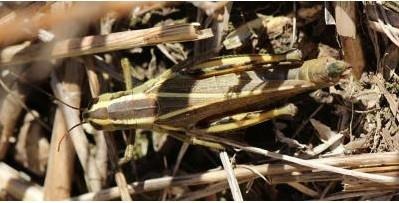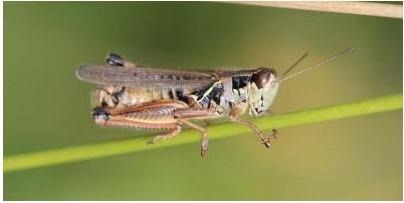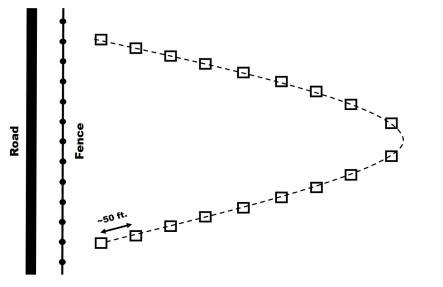By Adam Varenhorst
With much of South Dakota experiencing abnormally dry to extreme drought conditions this year, grasshoppers are one of the insect pests that will need to be monitored closely (Figure 1).

Figure 1. U.S. Drought Monitor for South Dakota. Released Thursday, June 10, 2021. Courtesy: U.S. Drought Monitor
Large grasshopper populations may cause economic loss in cash crops and reduce forage in range and pasture lands. The drought conditions will exacerbate the grasshopper issue as they will seek any plant material that is green during the growing season.
This will become more obvious as grassy areas such as road ditches begin to dry down and the grasshoppers are forced to seek alternative food sources.

Figure 2. Results from the U.S. Department of Agriculture (USDA) 2020 Adult Grasshopper Survey in South Dakota. Courtesy: USDA Animal and Plant Health Inspection Service
In 2020, there were large populations of grasshoppers that caused issues in Central South Dakota.
The 2020 USDA Adult Grasshopper Survey of Central and Western South Dakota indicated that there were several areas that had grasshopper populations that were above the threshold of eight grasshopper per square yard (Figure 2).
There were also large areas that were approaching the threshold. This data suggest that grasshopper populations could be a serious issue in those areas in 2021.
Identification

Figure 3. Two-striped grasshopper adult.
TWO-STRIPED GRASSHOPPER
Two-striped, redlegged, and differential grasshoppers are the three main species that are being reported in the areas with large grasshopper populations. Of these three species, the most common is the two-striped grasshoppers (Figure 3). These grasshoppers get their name because of the two light yellow lines that run on the back of their head to their abdomen where they converge near the middle of the wings. Two-striped grasshoppers are normally a tan to brown in color. They are approximately 1-1 ½ inches long

Figure 4. Redlegged grasshopper adult.
REDLEGGED GRASSHOPPER
Another grasshopper that has been reported is the redlegged grasshopper. These grasshoppers get their name from their red hind leg segment (Figure 4). Their bodies range in color from green to tan with black markings and they are 2/3 to 1 inch long.

Figure 5. Differential grasshopper adult.
DIFFERENTIAL GRASSHOPPER
The other large grasshoppers that are being reported are the differential grasshoppers. These vary in size from 1 1/8 to 1 ½ inches long. Their bodies are green to yellow in color and they have black chevron markings on their hind legs (Figure 5).
Scouting and Management Options

Figure 6. An example of a sampling pattern that can be used for grasshopper scouting. The dashed line represents the path to be traveled, while the squares represent areas that will be scouted for grasshoppers.
The two methods for determining if populations are at or above threshold are to use visual counts or a sweep net. For visual counts, estimate a square yard in front of you and count the number of grasshoppers jumping out of the area as you slowly walk towards it. For sweep netting, use a 15-inch diameter sweep net and capture grasshoppers in four pendulum swings (approximately one square yard of area) and count them. With either sampling method, we recommend repeating it several times in a pattern, such as the example in Figure 6, and calculating the average for increased accuracy.
The threshold for grasshopper populations that was established by the United States Department of Agriculture (USDA) for grasslands is 15-20 nymphs or 8-10 adults per square yard.
For crops, we recommend scouting for nymphs and adults both in field margins and within the fields. For field margins, management should be considered when nymph populations reach 50-75 per square yard and adult populations reach 21-40 per square yard. In the field, management should be considered when there are 30-45 nymphs per square yard or when there are 8-14 adults per square yard. If you observe silk feeding, or grasshoppers feeding on ear tips or developing kernels insecticide management should be considered. For soybean, if grasshoppers cause 20% defoliation after flowering or are feeding on developing pods insecticide management should be considered.
If thresholds are exceeded, an insecticide that is labeled for grasshopper management may be considered. A current list of insecticide sprays for use in soybean, corn and alfalfa can be found in the latest South Dakota Pest Management Guides.
In pastures and range, spreading poison grasshopper baits or baits containing Nosema locusta spores may be used to reduce populations. If treating earlier in the season while grasshoppers are still growing, an insect growth regulator (IGR) containing diflubenzuron may be applied to inhibit grasshopper development. However, please note that IGRs have no effect on adult grasshoppers and should only be used to manage developing nymphs.
Source : sdstate.edu